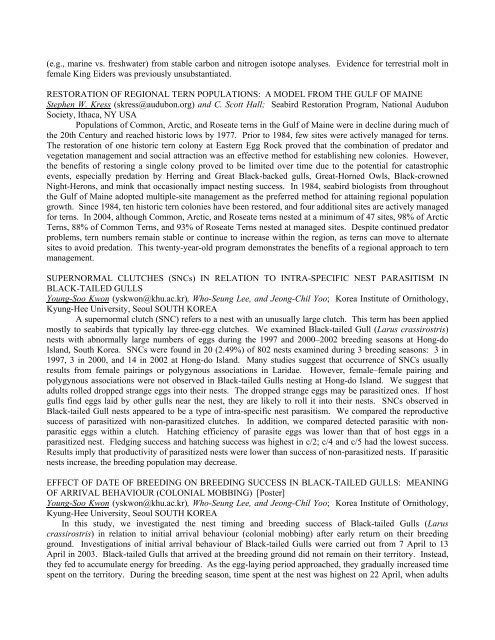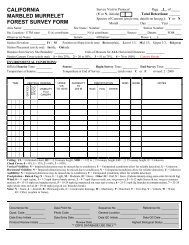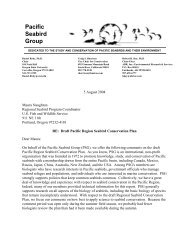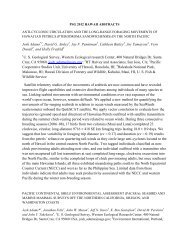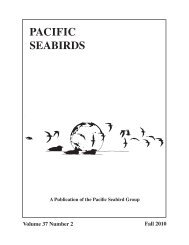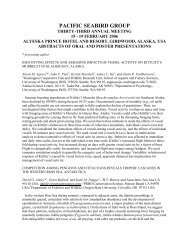abstracts of oral and poster presentations - Pacific Seabird Group
abstracts of oral and poster presentations - Pacific Seabird Group
abstracts of oral and poster presentations - Pacific Seabird Group
Create successful ePaper yourself
Turn your PDF publications into a flip-book with our unique Google optimized e-Paper software.
(e.g., marine vs. freshwater) from stable carbon <strong>and</strong> nitrogen isotope analyses. Evidence for terrestrial molt in<br />
female King Eiders was previously unsubstantiated.<br />
RESTORATION OF REGIONAL TERN POPULATIONS: A MODEL FROM THE GULF OF MAINE<br />
Stephen W. Kress (skress@audubon.org) <strong>and</strong> C. Scott Hall; <strong>Seabird</strong> Restoration Program, National Audubon<br />
Society, Ithaca, NY USA<br />
Populations <strong>of</strong> Common, Arctic, <strong>and</strong> Roseate terns in the Gulf <strong>of</strong> Maine were in decline during much <strong>of</strong><br />
the 20th Century <strong>and</strong> reached historic lows by 1977. Prior to 1984, few sites were actively managed for terns.<br />
The restoration <strong>of</strong> one historic tern colony at Eastern Egg Rock proved that the combination <strong>of</strong> predator <strong>and</strong><br />
vegetation management <strong>and</strong> social attraction was an effective method for establishing new colonies. However,<br />
the benefits <strong>of</strong> restoring a single colony proved to be limited over time due to the potential for catastrophic<br />
events, especially predation by Herring <strong>and</strong> Great Black-backed gulls, Great-Horned Owls, Black-crowned<br />
Night-Herons, <strong>and</strong> mink that occasionally impact nesting success. In 1984, seabird biologists from throughout<br />
the Gulf <strong>of</strong> Maine adopted multiple-site management as the preferred method for attaining regional population<br />
growth. Since 1984, ten historic tern colonies have been restored, <strong>and</strong> four additional sites are actively managed<br />
for terns. In 2004, although Common, Arctic, <strong>and</strong> Roseate terns nested at a minimum <strong>of</strong> 47 sites, 98% <strong>of</strong> Arctic<br />
Terns, 88% <strong>of</strong> Common Terns, <strong>and</strong> 93% <strong>of</strong> Roseate Terns nested at managed sites. Despite continued predator<br />
problems, tern numbers remain stable or continue to increase within the region, as terns can move to alternate<br />
sites to avoid predation. This twenty-year-old program demonstrates the benefits <strong>of</strong> a regional approach to tern<br />
management.<br />
SUPERNORMAL CLUTCHES (SNCs) IN RELATION TO INTRA-SPECIFIC NEST PARASITISM IN<br />
BLACK-TAILED GULLS<br />
Young-Soo Kwon (yskwon@khu.ac.kr), Who-Seung Lee, <strong>and</strong> Jeong-Chil Yoo; Korea Institute <strong>of</strong> Ornithology,<br />
Kyung-Hee University, Seoul SOUTH KOREA<br />
A supernormal clutch (SNC) refers to a nest with an unusually large clutch. This term has been applied<br />
mostly to seabirds that typically lay three-egg clutches. We examined Black-tailed Gull (Larus crassirostris)<br />
nests with abnormally large numbers <strong>of</strong> eggs during the 1997 <strong>and</strong> 2000–2002 breeding seasons at Hong-do<br />
Isl<strong>and</strong>, South Korea. SNCs were found in 20 (2.49%) <strong>of</strong> 802 nests examined during 3 breeding seasons: 3 in<br />
1997, 3 in 2000, <strong>and</strong> 14 in 2002 at Hong-do Isl<strong>and</strong>. Many studies suggest that occurrence <strong>of</strong> SNCs usually<br />
results from female pairings or polygynous associations in Laridae. However, female–female pairing <strong>and</strong><br />
polygynous associations were not observed in Black-tailed Gulls nesting at Hong-do Isl<strong>and</strong>. We suggest that<br />
adults rolled dropped strange eggs into their nests. The dropped strange eggs may be parasitized ones. If host<br />
gulls find eggs laid by other gulls near the nest, they are likely to roll it into their nests. SNCs observed in<br />
Black-tailed Gull nests appeared to be a type <strong>of</strong> intra-specific nest parasitism. We compared the reproductive<br />
success <strong>of</strong> parasitized with non-parasitized clutches. In addition, we compared detected parasitic with nonparasitic<br />
eggs within a clutch. Hatching efficiency <strong>of</strong> parasite eggs was lower than that <strong>of</strong> host eggs in a<br />
parasitized nest. Fledging success <strong>and</strong> hatching success was highest in c/2; c/4 <strong>and</strong> c/5 had the lowest success.<br />
Results imply that productivity <strong>of</strong> parasitized nests were lower than success <strong>of</strong> non-parasitized nests. If parasitic<br />
nests increase, the breeding population may decrease.<br />
EFFECT OF DATE OF BREEDING ON BREEDING SUCCESS IN BLACK-TAILED GULLS: MEANING<br />
OF ARRIVAL BEHAVIOUR (COLONIAL MOBBING) [Poster]<br />
Young-Soo Kwon (yskwon@khu.ac.kr), Who-Seung Lee, <strong>and</strong> Jeong-Chil Yoo; Korea Institute <strong>of</strong> Ornithology,<br />
Kyung-Hee University, Seoul SOUTH KOREA<br />
In this study, we investigated the nest timing <strong>and</strong> breeding success <strong>of</strong> Black-tailed Gulls (Larus<br />
crassirostris) in relation to initial arrival behaviour (colonial mobbing) after early return on their breeding<br />
ground. Investigations <strong>of</strong> initial arrival behaviour <strong>of</strong> Black-tailed Gulls were carried out from 7 April to 13<br />
April in 2003. Black-tailed Gulls that arrived at the breeding ground did not remain on their territory. Instead,<br />
they fed to accumulate energy for breeding. As the egg-laying period approached, they gradually increased time<br />
spent on the territory. During the breeding season, time spent at the nest was highest on 22 April, when adults


